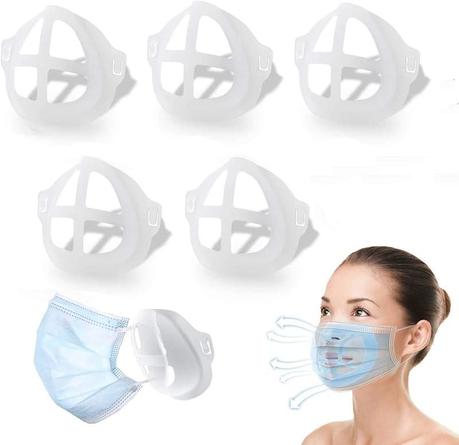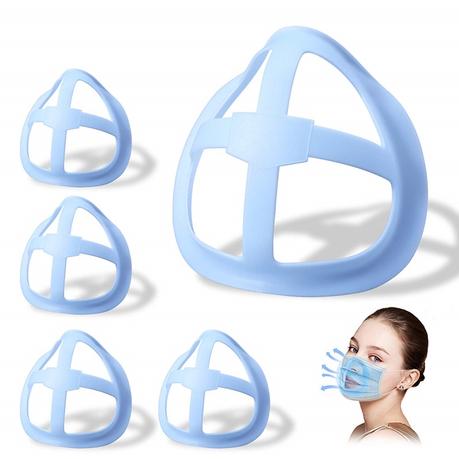Is maskne real? Should you use face mask brackets to prevent against maskne? This article discusses face mask brackets: what they are, how they work and whether they are recommended by medical experts.
What is a face mask bracket?

Nobody knows the day, the time nor hour. COVID-19 is here to stay- at least for now. And so are face masks. Many Americans have made peace with the fact that they will be wearing face masks into the foreseeable future. And it is not like Americans have a choice not to wear face masks. The CDC and other health agencies have not tired in reminding Americans to embrace the habit of wearing face masks whenever in a public setting. This, they argue, will help slow down the spread of the novel coronavirus.
Truth be said, wearing a face mask for long hours can be uncomfortable and irritating. It is claimed that the prolonged wearing of face masks causes maskne. Maskne is a skin irritation caused by wearing masks for a long time, specifically N95 respirators and cloth face masks.
It is for this reason that face brackets for masks are becoming popular here in the US. Face mask brackets are devices worn under the mask to act as a barrier between your skin and the mask. With this barrier, the mask does not lie directly on top of your mouth. For lipstick lovers: This can prevent your lipstick from smudging. It is also argued that face mask brackets prevent acne caused by prolonged wearing of face masks.
How do face mask brackets work?
Face mask brackets are also commonly referred to as mask extenders. These devices are made from Silicone. Although there are different brands of face mask brackets, all are designed to have a narrow top and a wide bottom. The top lies on your nose while the spread-out bottom nestles against the chin. They are T-shaped in the middle to cover your nose and mouth.
They have sizeable open-air vents that ensure that the cloth mask does not touch your mouth as you breathe. With this design, the mask braces create a barrier between your face and the mask you are wearing.
Face masks are meant to protect you from contracting coronavirus. On the other hand, face mask brackets keep that face mask away from your face. This design of face mask brackets has raised questions about their safety.
What do medical experts think about face mask brackets?

Questions about the safety of face mask brackets are best answered by infectious disease experts. As things stand, no official study has been conducted by either the CDC or other government health agencies about the safety of face mask brackets. There isn't enough scientific data to support a data-based medical opinion on face mask brackets. The efficacy of face masks, with or without face brackets, hasn't been well addressed by scientific research. This is why most medical professionals are reluctant to share their views on face mask brackets.
Medical experts from Cleveland Clinic Akron General say that they agree to the use of face mask brackets as it encourages people to adhere to the statewide requirement of wearing masks in public settings. In their opinion, although not backed up by scientific data, face mask brackets still allow cloth masks to prevent the exhalation of contaminated airborne particles. To them, anything that motivates people to wear their masks is welcome.
There are other infectious disease experts who hold a contrary opinion. These experts are concerned with the integrity of the seal. Richard Watkins, an associate professor of internal medicine at Northeast Ohio Medical University holds a similar view. He says that personally he cannot use face mask brackets. His argument is premised on the fact that face masks work by creating a good fit around the mouth and nose. It is with this seal that face masks create a barrier between the wearer and those in close physical contact.
Another infectious disease specialist who is of the view that face mask brackets make cloth masks less effective is William Schaffner, M.D. He is a professor at the Vanderbilt University School of Medicine. He urges caution when using face mask brackets. He advises that you check whether the bracket tempers with the seal. If it does, then it renders the mask less effective. He goes ahead to assert that judging by their design, face mask brackets are meant to be used inside surgical-style masks. His overall comment is that since masks are meant to protect you and others, it has to fit appropriately. If it doesn't fit properly then it is not doing what it was meant to do.
The CDC guidelines state that masks with two or more layers are more effective in helping slow down the spread of the novel coronavirus. When worn, the mask should fit properly and create a tight seal around your mouth and nose. The Center for Disease Control is yet to officially pronounce itself on the use of face mask brackets.
Another argument against face mask brackets is that Silicone, the material from which they are made, can cause skin irritation. This is when they are worn for a long for a long time and in hot weather. They are also people who are allergic to Silicone, plastic or any other component of the bracket.
According to Gary Goldenberg , an assistant clinical professor of dermatology at the Icahn School of Medicine at Mount Sinai in New York City ,the best way to deal with maskne is proper skincare. He also recommends the use of prescription acne creams to deal with maskne.
What options are available for face mask brackets?
With little known about the safety of face mask brackets, you are justified if you're hesitant in using them. If you happen to suffer from skin irritation as a result of prolonged wearing of face masks, you are better off with fitted masks. N95 or KN95 respirators are more comfortable options. They only rest on your skin at the sealed edges of the mask. The only challenge is that these respirators are not for general public use. Because of their high filtration efficiency, the CDC has recommended that they be reserved for frontline healthcare workers and medical responders.
Face shields could have been a suitable substitute but the CDC advises against their use. The CDC explains that face shields should be primarily used for eye protection.

